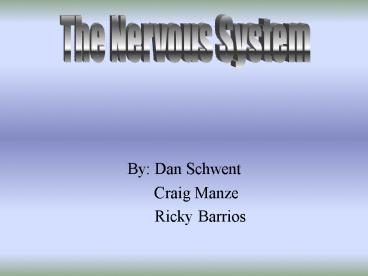By: Dan Schwent - PowerPoint PPT Presentation
1 / 13
Title:
By: Dan Schwent
Description:
The nervous system is the body's information gatherer, storage center, and control ... Diagnosis is complicated by protean clinical manifestations which are age ... – PowerPoint PPT presentation
Number of Views:59
Avg rating:3.0/5.0
Title: By: Dan Schwent
1
The Nervous System
- By Dan Schwent
- Craig Manze
- Ricky Barrios
2
Introduction
The nervous system is the bodys information
gatherer, storage center, and control system. Its
overall function is to collect information about
the external conditions in relation to the bodys
external state, to analyze this information, and
initiate appropriate responses to satisfy
certain needs. The main parts of the nervous
system are the brain, spinal cord, and nerves.
3
Nerves
Nerves are thin threads of neurons. Bundled
together and carry messages like a telephone
wire. Sensory nerves send messages to the brain
and generally connect to the brain to all the
muscles and glands in the body. When neurons are
stimulated by heat, cold, touch, sound vibration,
or some other message it begins to generate a
tiny electric pulse. This electricity and
chemical change travels the full length of the
neuron. The electrical pulse in the cell triggers
the release of chemicals that carry the pulse to
the next cell and so on. Dendrites receive
information from other cells and transmit the
message to the cell body.
4
Neurons
Nucleus
5
Message Sending
1 An external force causes the neurons to become
stimulated and receive a message. 2 The message
moves from the point of stimulation to the spinal
cord. 3 The message is then sent up the spinal
cord to the brain where it is interpreted and a
reaction is decided 4 The reaction to the
situation is then sent down the spinal cord to
the point of stimulation. 5Muscles cause a
reaction to the external force.
6
The Brain
The Brain is divided into the brainstem, the
cerebellum, Thalamus, Hypothalamus, Parietal
lobe, Temporal lobe, Frontal lobe, and Occipital
lobe. The Brainstem Regulates body processes
that are not consciously controlled, like
breathing and heartbeat. The Cerebellum
Coordinates voluntary muscle movements and
maintains muscle vigor and body balance. Temporal
Lobe Allows a person to tell one scent or sound
from a another. Sorts new information and is
responsible for short term memory.
7
The Brain contd.
Frontal Lobe Involved in planning, organizing,
problem solving, selective attention,
personality, and other higher cognitive
functions. Parietal Lobe Receives sensory
impulses, transmits motor impulses, and helps
process information. Occipital Lobe Processes
visual information. Hypothalamus Controls body
temperature, thirst, hunger, water balance, and
emotional behavior.
8
(No Transcript)
9
Misc. Information
1 The brain sends and receives messages to and
from all parts of the body. 2The brain is
encased in and protected by the skull. 3 The
spinal cord is encased in and protected by the
vertebrae. 4The spinal cord is a long cord-like
structure made by nerves connected to the brain.
It carries messages from the nerves to the
brain. 5 The nerves look like long threads
protruding from the spinal cord. 6 The nerves
are what receive external stimulation and send
the message up to the brain.
10
Meningitis
Bacterial meningitis is fairly uncommon, but can
by extremely serious. It is fatal in one in ten
cases and in one in seven survivors is left with
severe handicap, such as deafness or brain
injury. The bacteria that causes both
meningococcal and and pneummococcal meningitis
are vary common and live in the back of the nose
and throat. People of any age can carry these
germs for days, weeks or months without becoming
ill.
11
Tourette Syndrome
Tourette Syndrome is a neurological disorder
characterized by tics, involuntary, rapid, sudden
movements or vocalizations that occur repeatedly
in the same way. Diagnostic criteria include
One or more vocal tics present at some time,
although not necessarily simultaneously The
occurrence of tics many times a day nearly every
day or intermittently throughout the span of more
than one year Periodic changes in the number,
frequency, type and location of the tics, and in
the waxing and waning of their severity. Symptoms
can sometimes disappear for weeks or months at a
time Happens before the age of 18. The range of
tics or tic-like symptoms that can be seen in
Tourette is very broad. The complexity of some
symptoms is often perplexing to family members,
friends, teachers and employers who may find it
hard to believe that the actions or vocal
utterances are not deliberate. There is no cure
for Tourette Syndrome.
12
Epilepsy
Epilepsy represents the most common serious
neurologic problem affecting children, with an
overall incidence approaching 2 for febrile
seizures and 1 for idiopathic epilepsy.
Diagnosis is complicated by protean clinical
manifestations which are age-dependent and differ
substantially from adult seizure disorders. For
example, infantile may be misinterpreted as a
simple startle reflex and absence seizures are
sometimes attributed to inattention or attention
deficit. Effective treatment depends largely on
the physician's ability to give an accurate
diagnosis and choose appropriate therapy based on
the likelihood of clinical benefit as well as
potential side effects.
13
Craig Manze http//members.tripod.com/tourette13/
http//137.172.248.46/epilepsy.htm http//userwww
.service.emory.edu/mkarunu/meningitis.html The
Nervous System, Edward Edelson The Human Body An
Overview, Mark Kittredge Ricky Barrios Rand
McNally Atlas of the body and mind Macmillan
Encyclopedia of Science Peole.ne.mediaone.net www.
kidinfo.com www.waiting.com/brainfunction.html
Dan Schwent www.waiting.com The Nervous System,
Silverstein, Silverstein Silverstein www.innerbo
dy.com/htm/body.html www.eyenet.org/public/anatomy
/anatomy.html The Nervous System, Llamas































